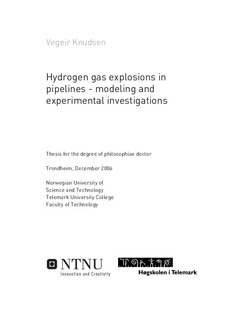| dc.contributor.author | Knudsen, Vegeir | nb_NO |
| dc.date.accessioned | 2014-12-19T11:24:32Z | |
| dc.date.available | 2014-12-19T11:24:32Z | |
| dc.date.created | 2007-07-23 | nb_NO |
| dc.date.issued | 2007 | nb_NO |
| dc.identifier | 122485 | nb_NO |
| dc.identifier.isbn | 978-82-471-0296-1 | nb_NO |
| dc.identifier.uri | http://hdl.handle.net/11250/231157 | |
| dc.description.abstract | Gas explosions in closed pipes with a single obstacle have been investigated both numerically and experimentally. Most of the work is related to hydrogen and air mixtures, but other fuels have also been used. At the present time there does not exist a software tool or a numerical method that single-handedly can cover the whole range of phenomena in gas explosions. Computational fluid dynamics is also a developing field, even for fluid flow without chemical reactions. The objective of this work was to develop numerical models that can be applied in predictive simulations of gas explosions in pipes and tunnels. Such predictive tools are important since they can expand the knowledge of gas explosions and thereby reduce the risk and consequences of gas explosion accidents.
The experiments were performed with premixed fuel and air at atmospheric conditions in three closed steel pipes. The pipes had an inner diameter of 107 mm and inner lengths of 3.0, 4.0 and 7.0 m. The various gas mixtures were ignited at the center of one end wall by a weak ignition source. Both the 4.0 and the 7.0 m pipe had an obstacle installed inside the pipe 1.0 m from the ignition wall. Four different fuels and seven different obstacles were used in the experiments. The obstacles had opening diameters ranging from 5 to 80 mm and the fuels were hydrogen, propane, methane and blends of hydrogen and carbon monoxide. Two types of Kistler pressure transducers were distributed along the pipes to measure the experimental overpressure. The experimental work has provided a unique data set which includes combustion regimes ranging from laminar flames to detonations. Several conditions which affect the flame propagation and transition to detonation in single obstructed pipes have been found.
The numerical work has been related to the one dimensional code RCMLAB. New numerical models have been developed and applied in the numerical simulations with this code. (The primary focus of these simulations were the flame propagation between the ignition wall and the obstacle.) The numerical simulations showed a high level of similarity between the measured experimental overpressure and the simulated overpressure at the various pressure transducer positions in the pipe. RCMLAB can therefore be used to enhance the understanding of gas explosions in pipes. Important parameters in the combustion process, such as the average burning rate, can be quantified by this numerical code. The numerical work performed in this thesis have also brought RCMLAB closer to becoming a predictive numerical code for simulation of gas explosions in pipes and tunnels. | nb_NO |
| dc.language | eng | nb_NO |
| dc.publisher | Fakultet for ingeniørvitenskap og teknologi | nb_NO |
| dc.relation.ispartofseries | Doktoravhandlinger ved NTNU, 1503-8181; 2007::14 | nb_NO |
| dc.title | Hydrogen gas explosions in pipelines - modeling and experimental investigations | nb_NO |
| dc.type | Doctoral thesis | nb_NO |
| dc.contributor.department | Norges teknisk-naturvitenskapelige universitet, Fakultet for ingeniørvitenskap og teknologi | nb_NO |
